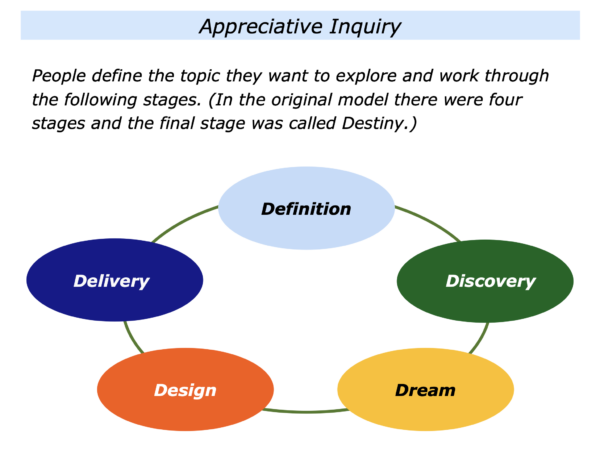
Appreciative Inquiry is a positive model for helping people, teams and organisations to develop. It studies humanity at its best and is based on what works.
AI can be used with small and big groups. Sometimes it can involve thousands of people. They are asked to share their ideas to help shape the future.
It has been used by people in all walks of life to tackle challenges in their daily lives, work and communities. People like the approach. They build on when they have performed brilliantly and aim to keep developing.
In my own work I have used elements of it when working with organisations in business. Every time people have applied the approach properly they have delivered success. Here is an introduction to the approach. It invites people to go through the following stages.
Definition
The approach starts by people defining the question to explore. It is also important to frame this in a positive way. For example:
How can we combine our strengths to do superb work? How can we be resilient when tackling a specific challenge? How can we keep developing after achieving a success?
Discovery
This involves people discovering when they have performed superbly in this area. When did they tackle a similar challenge successfully? What were the principles we followed? How did they translate these into action?
Dream
This involves people following these principles and translating them into setting a desirable goal. It is important that the goal is stimulating, stretching and will help them to achieve success.
Design
This involves people designing the strategies for achieving the goal. It is important for them to use their strengths, follow these chosen principles and do what is necessary to increase the likelihood of achieving success.
Delivery
This involves people following their chosen strategies, performing superb work and continually improving. They encourage each other on the journey and do their best to deliver the desirable goal.
Different people apply AI in different ways. Here is a video in which Jackie Kelm gives an introduction to AI. You can discover more about her work via the following link.
http://appreciativeliving.com/
Philosophy and Background
David Cooperrider helped to pioneer AI in the early 1980s. At that time he was a 24-year-old doing his doctorate and working alongside others doing organisational development work at The Cleveland Clinic.
The traditional approach would have been to focus on the deficits in people’s performance. David was committed to helping people to improve, but he chose to do this by focusing on strengths.
Employees were invited to study their own and other people’s peak performances. People found that revisiting their own successes, for example, ignited their desire to create an even better future.
David and his team had discovered a gold mine. He asked the Clinic’s Chairman, Dr William Kiser, if he could focus totally on this positive approach.
The Chairman encouraged him to go ahead. David and his project supervisor, Suresh Srivastva, would later write:
Human systems grow in the direction of what people study.
Put another way:
What we focus on, we become.
If we study positive solutions, for example, we are more likely to feel optimistic and solve issues. If we study failure, we are more likely to feel despondent.
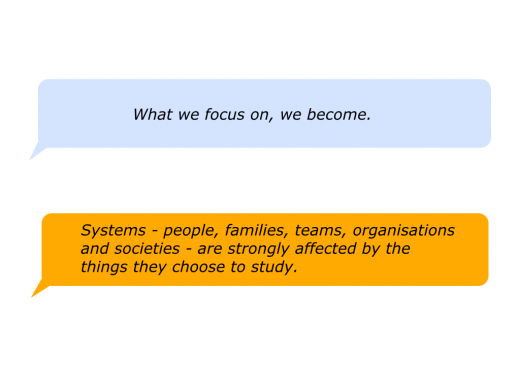
This rule proved to be the case at the Cleveland Clinic. The staff loved learning from past successes and wanted to follow these principles in the future. They translated these into tackling specific challenges and producing concrete results.
Diana Whitney also helped to shape the framework that became Appreciative Inquiry. Working with David, she co-authored the first book on the topic called Appreciative Inquiry: A positive revolution in change.
Here is a video in which Diana describes how systems follow the direction that they study. You can discover more about the work done by she and her colleagues via the following link.
Defining The Topic
As mentioned earlier, AI starts by inviting people to clarify the topic they want to explore. It can be useful:
To define the challenge they want to tackle and frame this in a positive way;
To clarify the real results they want to achieve.
This Definition process is one that some people see as the Fifth D in the AI framework. It comes before focusing on Discovery, Dream, Design and Delivery.
“But you can’t frame every challenge in a positive way?” somebody may say.
Some situations are difficult, but this is where AI excels. It is vital to define the topic in a way that inspires people to want to achieve the goal.
Creative people, for example, often frame their challenges in a positive way. They may move from converting the following first statements to the second statements.
How can I stop feeling bad? How can I start feeling good?
How can we stop arguing? How can we, as far as possible, find a win-win?
How can reduce sexual harassment? How can we encourage women and men to work together successfully?
David was actually confronted by this final topic. One day he received a phone call from a consultant who was helping a company to tackle sexual harassment.
During the previous two years the employees had been attending training designed to eliminate this issue. But the levels of sexual harassment were actually increasing, as were the lawsuits against the company.
The consultant in charge of the gender and diversity training asked David:
How would you take an appreciative approach to sexual harassment?
David asked about the real results to achieve. The reply was:
We want to dramatically cut the incidence of sexual harassment. We want to solve this huge problem.
Going deeper, David asked what this would look like. The consultant said:
What we really want is to see the development of a new century organisation – a model of high quality cross-gender relationship in the work place.
Though this wording was somewhat awkward, it clarified a positive picture of success. So eventually the questions posed to people during the following Discovery stage were along the lines of:
When have women and men have worked together successfully in the company? What did they do right then? How can we follow those principles in the future?
The company introduced a small pilot programme on this theme. This exceeded everybody’s expectations.
Hundreds of pairs and teams nominated themselves to provide stories illustrating men and women working together successfully in the company.
Defining the topic is crucial. It creates the framework within which people can channel their positive energy.
Once the topic is chosen, they can then embark on the Discovery part of the AI process. Here are some suggestions people can following for defining the topic.
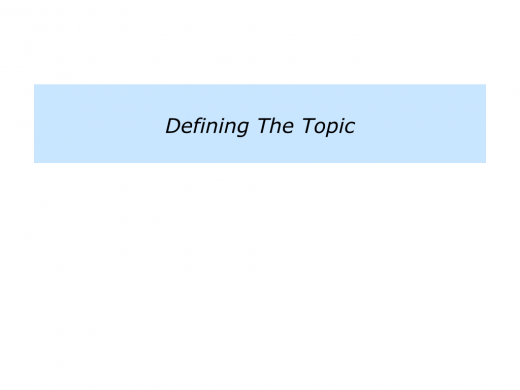
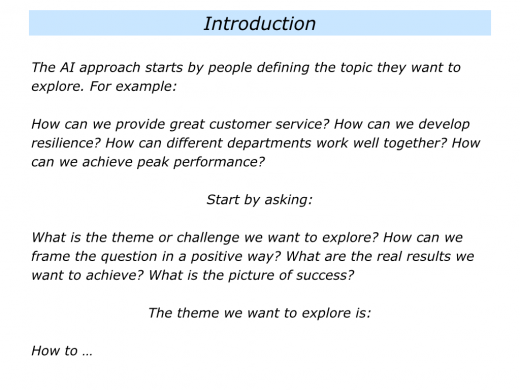
Discovery
The Discovery phase taps into the positive core – the life-giving forces of a team, organisation or community. AI can be applied in teams or with literally thousands of people. The latter is sometimes called an AI Summit.
AI invites people to discover what works. It explores the stories, strengths and successful patterns already within the system.
Here is a framework that people can follow during the Discovery stage. If appropriate, they can then present their findings back to the whole group.
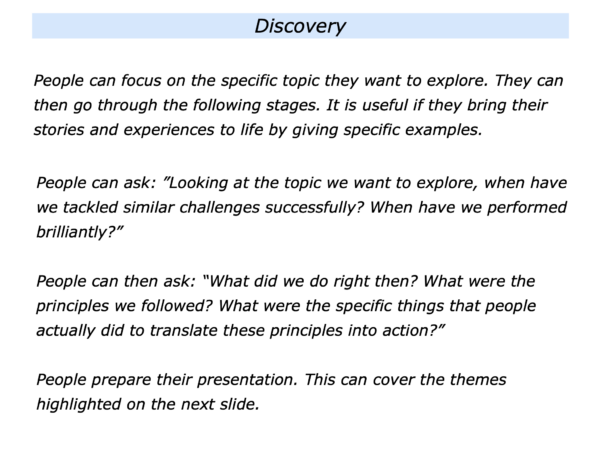
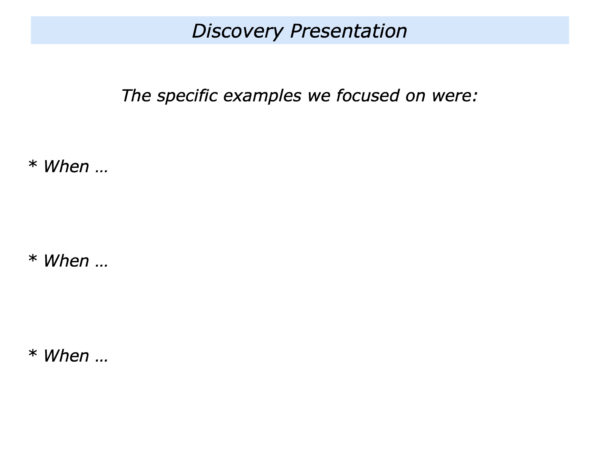
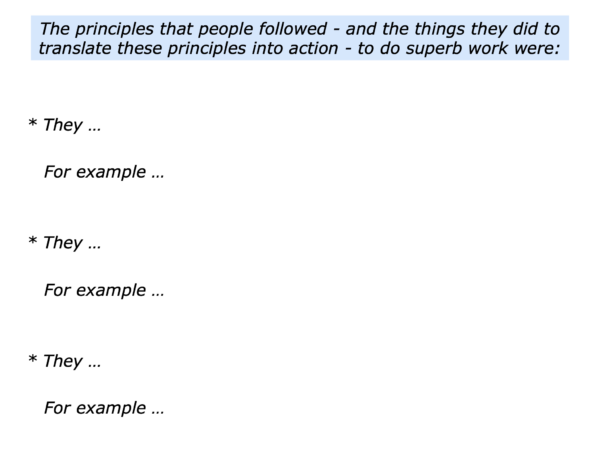
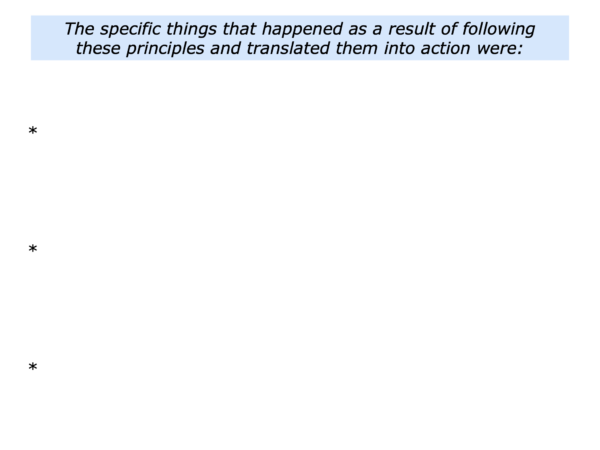
Dream
Appreciative Inquiry is different from most visioning approaches in a crucial way. It builds on the stories, strengths and successful principles that have already emerged. People are doing several things.
They are building on the organic principles they know work;
They are then more confident about extrapolating these principles into the future;
They see how these principles might be expressed in a picture of success.
People may be dreaming but, because they are following successful principles, they have a belief they can deliver. This is because they have started from within. The dream is organic, rather than something grafted on.
AI practitioners find the Dream and Design parts sometimes start to overlap. This is okay, because there is often a moving forwards and backwards between the two elements.
There are, however, a few things to mention in relation to defining the dream. It can be useful:
To make sure the dream is an expression of the principles that people know have worked already;
To make sure the dream is stimulating, stretching and yet within the scope of the controllables – the things they can control in the situation;
To, if appropriate, invite people to make a picture – or other representation – of them achieving the dream.
People can draw a picture to show what will actually be happening when they reach the goal. They can bring this to life by adding the actual words they want to be hearing from customers, colleagues, the press and other stakeholders. They can then put the picture in a place where they see it each day.
One key point is worth underlining. People who deliver a dream are often positive realists. They have a positive approach, but they are also realistic.
They are a bit like mountain climbers. They focus on achieving a particular goal, but they also do their due diligence. Such people often go through the following stages when testing the validity of their aim.
They clarify the pluses and minuses involved in working towards and achieving the goal. They clarify what it will mean for all the stakeholders.
They clarify how to build on the pluses and minimise the minuses. They clarify whether they are prepared to accept the whole package.
They sometimes do this by asking: “On a scale 0 – 10, to what extent are we really serious about doing what is required to achieve the goal?” They make sure the rating is at least 8+/10.
Here is a framework people can follow during the Dream stage. They can then present these findings to the whole group.
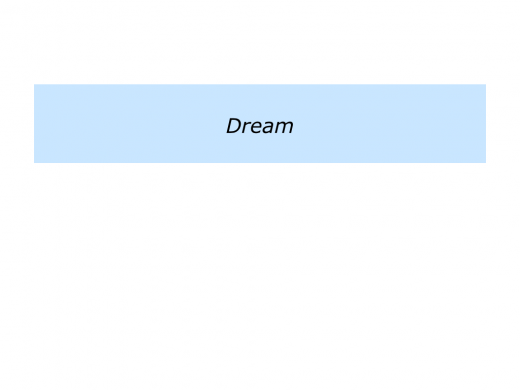
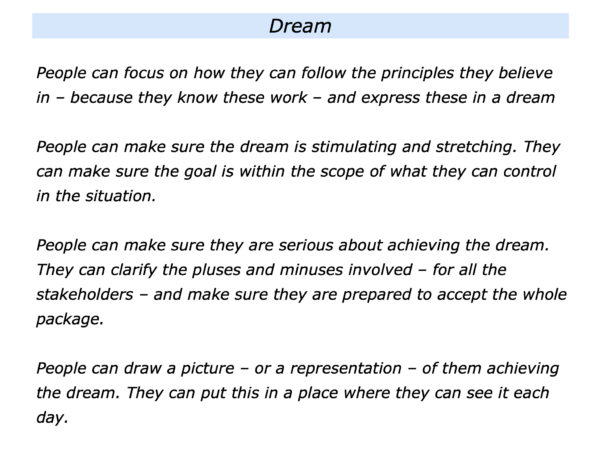
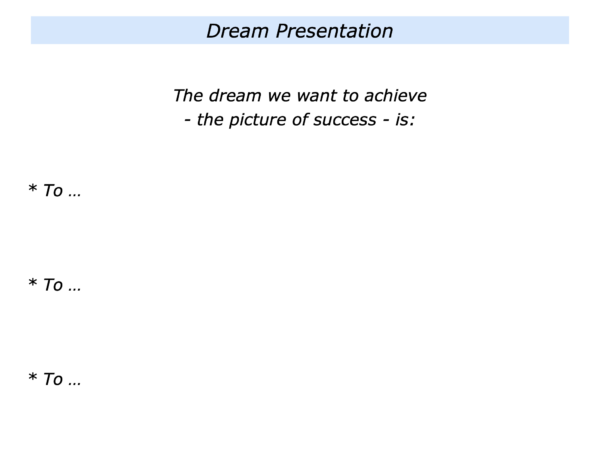
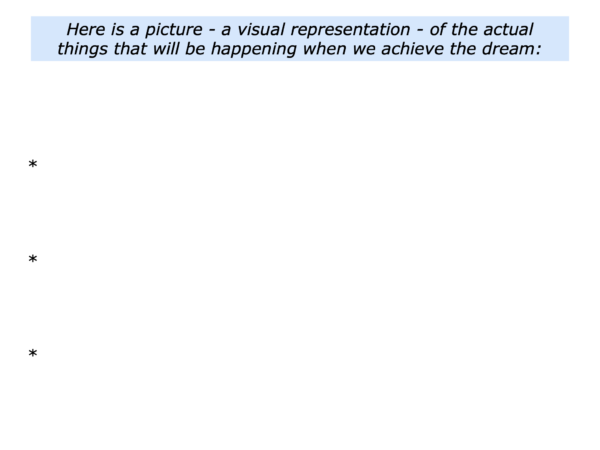
Design
The Dream is the ‘What’ – the real results to achieve – and the ‘Why’ – the benefits of achieving the goal. The Design is the ‘How’ – the strategies for achieving the goal.
Different people use different approaches to clarifying their strategies. You will, of course, have your own method.
Here is one approach. Bearing in mind the picture of success, people may ask some of the following questions.
What are the key strategies we can follow to give ourselves the greatest chance of success? How can we implement these strategies successfully? What support will people need to deliver success?
What are people’s strengths? How can we build on and co-ordinate these strengths to reach the goal? How can we compensate for any weaknesses?
What are the potential difficulties people may face along the way? How can we anticipate and prevent these difficulties happening? How can we manage the difficulties if they do happen?
How can people encourage themselves on the journey? How can they keep building on what works? How can they find solutions to other challenges? How can people get some quick successes?”
What is the road map – the action plan – for achieving the dream? Who will need to deliver what and by when? What will be the actual things that will be happening that will show we have reached the goal?
Sometimes this calls for radical approaches to redesigning an organisation. David explains:
People are encouraged to ‘wander beyond’ the data with the essential question being this:
‘What would our organization look like if it were designed in every way possible to maximize the qualities of the positive core and enable the accelerated realization of our dreams?’
When inspired by a great dream we have yet to find an organization that did not feel compelled to design something very new and very necessary.
Here is a framework that people can use during the Design stage. They can then, if appropriate, present these findings to the whole group.
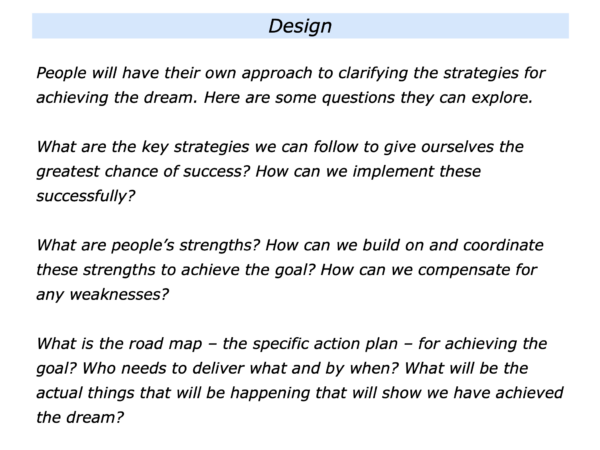
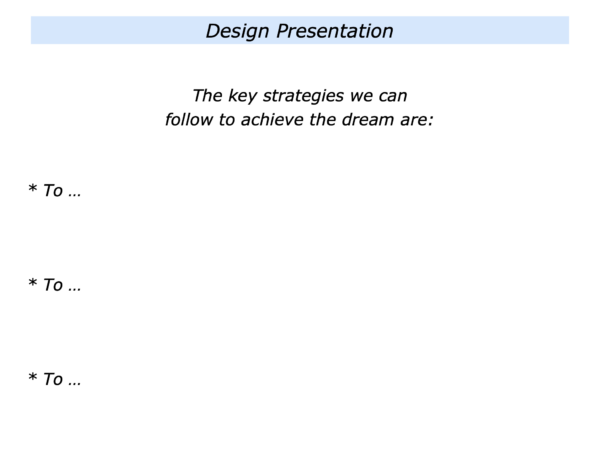
Delivery – Originally Called Destiny
This phase translates the dream into reality. People throw themselves into the work and get some early wins.
Maintaining the momentum is crucial, so it is vital to have follow up meetings. One approach is to gather people together at least once a month to report their progress.
If you are running such sessions, keep people’s eyes on the big picture. You can start, for example, by reminding people of the Dream. People can then be invited to present the following things.
The specific things we have delivered in the past month towards achieving the dream;
The specific things we plan to deliver in the next month.
If appropriate, they can also describe: a) the specific challenges they face and their plans for tackling these challenges; b) the specific support they would like; c) the specific other topics they would like to explore regarding how to deliver the dream.
You can encourage people to build on their successes and develop the habit of constant improvement. Here is the framework that people can use to focus on the progress towards achieving the dream.
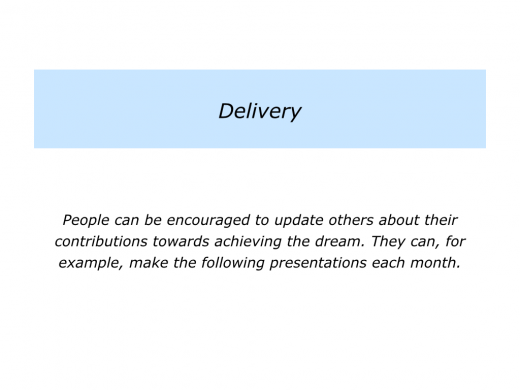
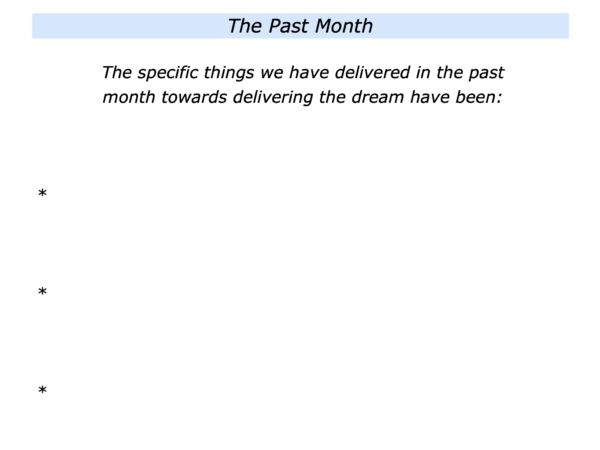
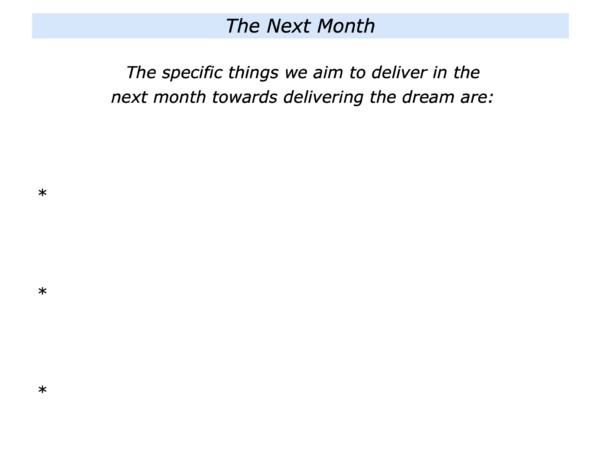






Leave a Reply